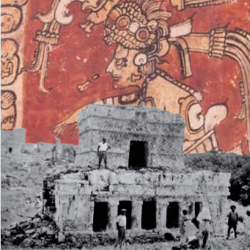 By P. Sufenas Virius Lupus
By P. Sufenas Virius Lupus
In "Here, There, and Anywhere," an essay by University of Chicago scholar Jonathan Z. Smith in Prayer, Magic, and the Stars in the Ancient and Late Antique World, many ancient religions (including Christianity and Judaism) were classified along the lines of their primary locus of activity.
"Here" religions are focused upon the domestic sphere and familial concerns (including ancestor worship, fertility, and health/healing). "There" religions are civic, regional, ethnic, or even national, and often are centered in temples and places of pilgrimage, and have established mores and laws associated with them, which can include exclusive membership or access (e.g., only people who were to some extent Greek-speakers could partake in the Eleusinian Mysteries; there was a Greek-specific and a Thracian-specific cult and celebration of the goddess Bendis present in Athens; etc.). "Anywhere" religions tend to be somewhat personal and yet universalizing and communal in their focus, and can be practiced regardless of one's location or origin.
Both Christianity and the Mithraic religion, for example, began as "Anywhere" religions, the latter because its main adherents -- soldiers and merchants -- were often prevented from participating in "Here" and "There" religious activities due to their wide travel and often great distance from their individual domestic or ethnic spheres. As these religions developed, however, they became more and more "There" religions in their focus, with fixed places of worship, community memberships, and orthopraxic spiritual activities.
There is variation observable within these classifications, and a certain degree of crossover between categories within individual religions or discrete religious activities eventually becomes somewhat inevitable. Just as this model can be useful for looking at and understanding the differences between the religions of late European/Mediterranean antiquity, so too can this paradigm be applied to modern forms of Paganism.
Modern forms of Paganism tend to be both "Here" and "Anywhere" in their general orientations. Few Pagans, for example, can be said to take part regularly in large gatherings, and nearly all probably have little access to shared ritual spaces, public temples, or other such phenomena of "There" religions. However, nearly all are likely to have some sort of individual practice that takes place primarily in their own homes on a regular basis, which is often concerned with prosperity, health, well-being, and connecting to one's local landscape, all of which are "Here" religion characteristics. Likewise, many Pagans have been trained in or consider themselves a part of a larger group, coven, theological movement, or tradition, most of which make themselves available to people wherever they might be located and no matter who they may be, thus pointing toward an "Anywhere" orientation.
Certain large groups and organizations (e.g., Circle Sanctuary, Covenant of the Goddess, Fellowship of Isis), national or international traditions (e.g., Feri, various Wiccan lineages, Asatru), as well as certain yearly festivals and activities (e.g., Pagan Spirit Gathering, PantheaCon, Aquarian Tabernacle Church's Spring Mysteries) have many characteristics of "There" religious phenomena, but usually without the emphasis on "purity," strict cultic rules, or ethical requirements (beyond simple ones involving not harming others), and certain other exclusivist tendencies within that variety of spiritual structure. But, what would the ideal balance between or among these religious styles be, particularly as it concerns modern Paganism and its foreseeable future?
It has often been said that Pagan religions are religions of practice and religions of experience, and not creedal religions -- in other words, what one does is more important than what one believes. In such cases, orthopraxy is preferred to orthodoxy. And yet, the reality in most modern Paganism -- and a great deal of ancient Paganism! -- is that polypraxy (in the terminology of Erynn Rowan Laurie) is more the norm than orthopraxy. It is still more about what one does, and that one does do something, than it is about everyone doing the same thing, or even vaguely similar things.
It is far more important to have someone doing a practice that works for them and that they find effective and meaningful -- whether created from whole cloth or cobbled together and/or modified from existing practices by other people or groups -- than it is to have everyone marching in the same lock-step pattern. This is, most certainly, a good thing overall in terms of having a religion that is useful and workable for a wide variety of people, and the wider demographics of modern Pagans are most certainly diverse and individual.



